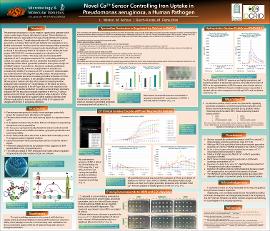| dc.contributor.advisor | Patrauchan, M. | |
| dc.contributor.author | Winton, L. | |
| dc.contributor.author | Achour, M. | |
| dc.contributor.author | Burch-Konda, J. | |
| dc.contributor.other | Wentz Research Scholars | |
| dc.date.accessioned | 2023-05-25T15:45:26Z | |
| dc.date.available | 2023-05-25T15:45:26Z | |
| dc.date.issued | 2023-04-27 | |
| dc.identifier | oksd_wentz_2023_winton | |
| dc.identifier.citation | Winton, L., Achour, M., Konda-Burch, J., Patrauchan, M. (2023). Novel Ca²⁺ sensor controlling iron uptake in Pseudomonas aeruginosa, a human pathogen. Poster session presented at the Oklahoma State University Wentz Research Scholars Symposium, Stillwater, OK. | |
| dc.identifier.uri | https://hdl.handle.net/11244/337731 | |
| dc.description.abstract | Pseudomonas aeruginosa is a Gram negative, opportunistic pathogen which causes a wide range of severe infections in humans. These infections are difficult to treat and, especially in the lungs of cystic fibrosis (CF) patients, often become chronic. Complicating eradication of P. aeruginosa is pyoverdine, a virulence factor which aids bacterial iron acquisition in iron-limited environments. Previous work has shown that pyoverdine production in P. aeruginosa strain PAO1 is increased under elevated levels of Ca²⁺, as are found in the pulmonary fluids of CF patients. A Ca²⁺-binding EF-hand protein, EfhP (PA4107), was demonstrated to be critical for the Ca²⁺-regulated virulence in PAO1. This study seeks to characterize EfhP regulation of the P. aeruginosa response to Ca²⁺, particularly pertaining to critical iron uptake pathways. We have established that deletion of efhP significantly hinders PAO1 pyoverdine production when grown at high Ca²⁺ in BMM8 medium. Pyoverdine is a fluorescent molecule quantified by measuring fluorescence at 400 nm excitation/460 nm emission and normalized by OD600. The presence of efhP in several CF clinical isolates was confirmed with PCR using efhP-specific primers. We observed that these clinical isolates also show increased pyoverdine production at 5 mM Ca²⁺ vs. the no Ca²⁺ condition. In the clinically relevant synthetic cystic fibrosis sputum medium (SCFM), PAO1 shows increased pyoverdine production with increasing Ca²⁺ concentrations. In the future, we aim to identify specific sequences in the efhP gene that are most important to the regulation of pyoverdine production by testing a series of strains expressing mutated EfhP. We also plan to evaluate expression of efhP in CF clinical isolates and test for their pyoverdine production when cultured in SCFM. The new knowledge gained can support further studies to develop novel efficient medications to improve the quality of life of CF patients who struggle with chronic P. aeruginosa infections. | |
| dc.description.sponsorship | Lew Wentz Foundation | |
| dc.format | application/pdf | |
| dc.language | en_US | |
| dc.publisher | Oklahoma State University | |
| dc.rights | In the Oklahoma State University Library's institutional repository this paper is made available through the open access principles and the terms of agreement/consent between the author(s) and the publisher. The permission policy on the use, reproduction or distribution of the article falls under fair use for educational, scholarship, and research purposes. Contact Digital Resources and Discovery Services at lib-dls@okstate.edu or 405-744-9161 for further information. | |
| dc.title | Novel Ca²⁺ sensor controlling iron uptake in Pseudomonas aeruginosa, a human pathogen | |
| osu.filename | oksd_wentz_2023_winton.pdf | |
| dc.description.department | Microbiology and Molecular Genetics | |
| dc.type.genre | Poster | |
| dc.type.material | Text | |
| dc.type.material | Image | |
| dc.subject.keywords | Pseudomonas aeruginosa | |
| dc.subject.keywords | calcium | |
| dc.subject.keywords | iron | |
| dc.subject.keywords | pyoverdine | |
| dc.subject.keywords | EfhP | |
